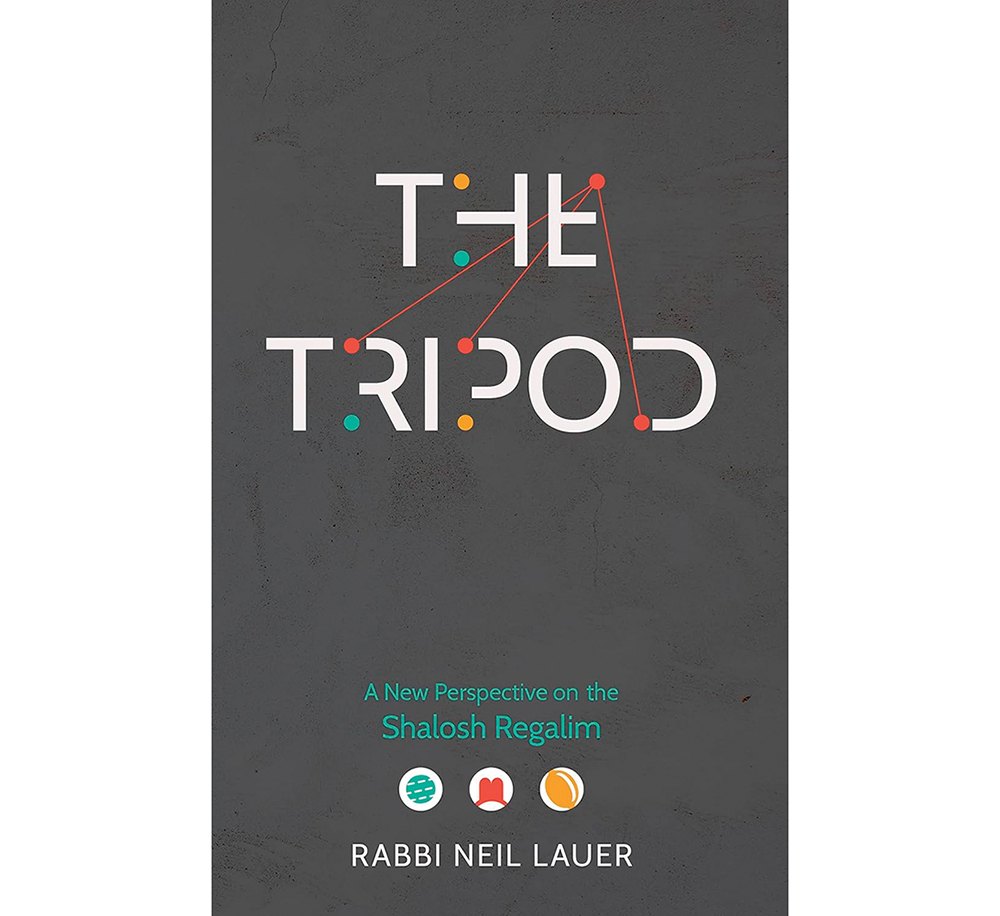
Reviewing: “The Tripod: A New Perspective on the Shalosh Regalim,” by Rabbi Neil Lauer. Mosaica Press. 2022. English. Hardcover. 302 pages. ISBN-10: 1957579137.
I recently had the opportunity to read “The Tripod: A New Perspective on the Shalosh Regalim” by Rabbi Neil (Nachman) Lauer of Teaneck (Mosaica Press 2022). Rabbi Lauer leads the reader through an exploration of the deeper meaning of the three regalim (festivals), with an emphasis on seeing them as one complete structure rather than as individual holidays.
Rabbi Lauer ambitiously seeks to create one unified picture out of the multiple facets of distinct regalim. In order to do so, he sets out to explain the relationship between parallel rituals from different holidays, as well as the different rituals of the same holiday. For example, he compares the korban ha-omer (the meal offering brought on the second day of Pesach) with the special breads that are offered on Shavuot (the shtei ha-lechem) while also situating the korban ha-omer within the context of other Pesach rituals. Rabbi Lauer connects the details of his analysis to larger themes, such as the relationship between the historical and agricultural aspects of the holidays, or the relationship between the halacha and Aggada of the holidays.
Having worked in education for many years, I am accustomed to preparing lessons where it is more important for students to ask the right questions than to come up with a particular answer. In that vein, my favorite part of the book is the first couple of chapters, where Rabbi Lauer lays out the challenges associated with his goal. In these early chapters, he surveys the holiday passages in the Chumash and raises some of the difficulties and inconsistencies in these passages. For example, do the holidays commemorate historical events or agricultural seasons? How does Shemini Atzeret fit into the cycle of regalim? He includes several helpful tables that summarize these issues in a format that will benefit visual learners. Each table could serve as the centerpiece of a source sheet if one were preparing a lesson about the regalim.
The enterprise of weaving so many details into one big picture is never simple, and this struck me as the greatest challenge that Rabbi Lauer faces. For example, in his chapter about the Ten Makkot, Rabbi Lauer divides them into three groups and then draws parallels between this grouping of three and other important groupings of three, such as the three regalim and the three fundamental principles of faith articulated by Rabbi Yosef Albo (author of the Sefer Ha-Ikkarim). In order for all of these threesomes to line up neatly—with each group of plagues paralleling one festival and one principle of faith—the author adopts particular interpretations of each element, drawn from specific traditional commentators. It was impressive to see the range of sources that Rabbi Lauer utilized to support his structure, but the downside of any such endeavor is that it necessarily deemphasizes alternative interpretations of each data point that do not fit into the larger structure that the author is building.
In his professional life, Rabbi Lauer commutes from Teaneck to Brooklyn on mass transit. He begins many chapters with analogies from his commute that he then employs as metaphors for aspects of the regalim. For example, he draws a parallel between the Port Authority Bus Terminal’s use of signs calling for vigilance against suspicious packages and the role that agriculture plays in the cycle of regalim. The humor in these analogies make for a pleasant read, especially for readers (myself included) who also commute to NYC on mass transit.
Before concluding, I will add two practical observations from reading the book: First, the book assumes familiarity with basic Hebrew terminology, so a reader who cannot recognize words such as kohanim or kiddush would struggle to understand it. (Less familiar terms are translated and explained.) At the same time, the frequent use of these Hebrew terms gives the book a warm, friendly feel for the apparent target audience: readers who are familiar with basic Jewish concepts and are looking to enrich their understanding of the Jewish festivals. Second, I would recommend that readers try to read through the book in a timely manner. Each of the 21 chapters builds on previous ones, so if you read a chapter here and a chapter there over the course of several months you may find yourself struggling to recall earlier material that is central to the argument presented in a later chapter.
In conclusion, “The Tripod” endeavors to understand the three regalim—including all their rituals and ideas—as one coherent unit. As Rabbi Lauer builds his case for this perspective, he guides the reader step by step through a broad range of classical sources, keeping the reader engaged through his entertaining analogies from the world of mass transit. ”Tripod” is an enjoyable read that offers a deeper understanding of the cycle of festivals.
Rabbi Frazer teaches limudei kodesh at Heschel High School in New York and serves as a Jewish chaplain in the U.S. Air Force Reserve. He received semicha from RIETS and from the Chief Rabbinate of Israel and holds a PhD in Bible from Yeshiva University. He lives with his family in Teaneck.









